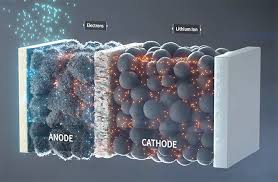
Lithium-Silicon Batteries: The Future of High-Energy Storage
Lithium-silicon batteries are emerging as a promising alternative to traditional lithium-ion batteries, offering significantly higher energy densities and improved performance. By incorporating silicon into the anode, these batteries aim to overcome the limitations of graphite-based anodes, unlocking new possibilities for energy storage in various applications, including electric vehicles (EVs), portable electronics, and renewable energy systems.
Why Lithium-Silicon Batteries?
Lithium-silicon batteries address the growing demand for high-capacity energy storage solutions:
- Higher Energy Density:
- Silicon anodes can store up to 10 times more lithium ions compared to graphite, significantly increasing energy capacity.
- Improved Cycle Life:
- Advanced designs and materials enhance the durability and longevity of the batteries.
- Faster Charging:
- Silicon anodes allow for quicker lithium-ion transport, enabling faster charging times.
- Reduced Weight:
- Higher energy density reduces the overall weight of battery systems, making them ideal for EVs and portable devices.
Challenges in Lithium-Silicon Batteries
Despite their potential, lithium-silicon batteries face several challenges:
- Volume Expansion:
- Silicon expands up to 300% during lithium-ion intercalation, causing mechanical stress and degradation.
- Electrolyte Decomposition:
- Repeated expansion and contraction lead to the formation of an unstable solid electrolyte interphase (SEI), reducing battery efficiency.
- Cycle Life:
- Maintaining long-term stability and performance requires advanced material engineering.
- Manufacturing Complexity:
- Producing high-quality silicon anodes at scale remains a technical hurdle.
Innovations in Lithium-Silicon Batteries
- Nanostructured Silicon Anodes:
- Using nanoscale silicon particles or nanowires to mitigate volume expansion and improve stability.
- Composite Materials:
- Blending silicon with graphite or carbon to enhance mechanical strength and conductivity.
- Advanced Electrolytes:
- Developing electrolyte formulations that stabilize the SEI and support silicon’s expansion.
- Protective Coatings:
- Applying thin, durable coatings to silicon anodes to prevent degradation.
Applications of Lithium-Silicon Batteries
- Electric Vehicles (EVs):
- Enables longer driving ranges and faster charging times, addressing key consumer demands.
- Portable Electronics:
- Powers high-energy devices like smartphones, laptops, and wearables with extended battery life.
- Renewable Energy Storage:
- Supports grid-level energy storage for solar and wind power, facilitating clean energy adoption.
- Aerospace and Defense:
- Provides lightweight, high-capacity power sources for advanced systems and equipment.
Advantages of Lithium-Silicon Batteries
- Increased Energy Capacity:
- Stores more energy in a smaller footprint, ideal for compact and lightweight designs.
- Enhanced Performance:
- Delivers higher power output and faster charging capabilities.
- Sustainability:
- Reduces reliance on traditional materials, supporting greener energy solutions.
- Cost Efficiency:
- Potential to lower costs with scalable production of silicon anodes.
Future Directions
- Material Innovations:
- Exploring alternative silicon morphologies and composite materials to optimize performance.
- Recycling and Sustainability:
- Developing efficient recycling processes for lithium-silicon batteries to minimize environmental impact.
- Integration with IoT:
- Incorporating batteries into smart systems for energy monitoring and optimization.
- Global Collaboration:
- Fostering partnerships between academia, industry, and governments to accelerate development and deployment.
Conclusion
Lithium-silicon batteries represent a significant leap forward in energy storage technology, offering unparalleled energy density and performance. While challenges remain, ongoing research and innovation are paving the way for their commercialization and widespread adoption. As these batteries become more accessible, they will play a crucial role in driving the transition to sustainable energy and transforming industries reliant on efficient power solutions.
